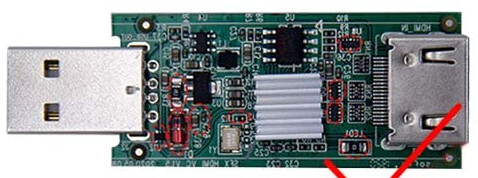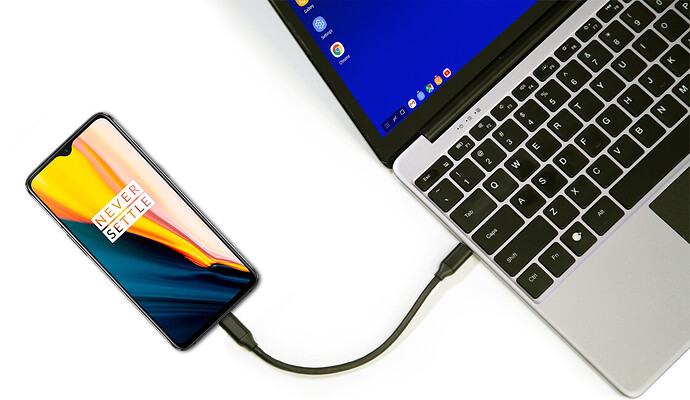Please, do consider a lapdock and/or the possibility to use the Framework Laptop components (display, keyboard, touchpad, etc, aside from CPU) powered by an Android (capable) phone via USC C Type-C 3.2, with a built-in stand and cables. Thanks!
That would definitely be interesting, and we hope that someone can come in and develop a custom mainboard module to enable that. Our model of modularity certainly makes it technically possible.
Damn, that’s a usecase I didn’t even think about, but it would indeed be possible! From what I can see in teardowns of the original Lapbook, the PCB inside it should fit into the Framework, all you’d need to make is an adapter/carrier PCB.
Sounds like an awesome project indeed!
Just a thought, if we had a hdmi capture expansion card, wouldn’t it be possible in software?
@Matt1 Nice, that’s quite the idea! The dongle in the thread you linked seems quite compact already:
But it’s probably still quite a bit bigger than what would fit into an expansion module. Maybe it could be optimised a little more.
One additional thing you also need would be a USB Host-to-host bridge where the keyboard and mouse input from the Laptop can be sent to the phone as if the laptop was itself a USB-Hub with a keyboard and a mouse. Not too difficult technologically, any small IC with USB device support will do.
I also think you wouldn’t want to use HDMI for this but USB-C so you can actually send keyboard and mouse signals to the Laptop, similar to how the Lapdock 2 does it:
Which would mean you need another IC for getting the display signal from the USB-C device.
So the BOM would be something like:
- 2-Port USB-C DP-alternate capable Hub IC
- 2 USB device-capable ICs
- USB-C to DisplayPort IC
- DisplayPort to MIPI IC
- MIPI-Capable MCU for capture
- All the passive support components
There may be some devices that incorporate multiple of these (MIPI and USB device ports seem the most obious), but it still seems quite hard to believe that all of this could fit into a single expansion module.
The only way it may be doable is to have a single, probably very beefy MCU that can handle the USB-C connection including DisplayPort in software, which is extremely difficult and time-intensive to write.
And then you’d still need to write the software on the actual PC, which of course has to be running, so you wouldn’t even get the same battery life.
It does sound like an awesome technical challenge and would be an amazing feature, but I’m not seeing it happen any time soon to be honest. Having a different motherboard inside seems much more attainable.
Also check out the official Google USB docks: What to expect from new Works With Chromebook docking stations | Google Cloud Blog They work with Mac and Windows too, so probably Linux as well(?).
That seems like a really good idea. With this as one of the products i could imagine framework becoming a rival to the big 5
The HDMI input card could instead be a Raspberry Pi Zero with the HDMI to CSI running TinyPilot to relay keystrokes and video.
I would really love to see this happen and be a thing. Rather than using an expensive and bottlenecking thunderbolt egpu and dock, make the entire computer external. A small itx rig is the same size as an egpu and sometimes smaller and for sometimes even the same price with far better performance. As for on the go, you could just hook up your phone and use that as a laptop (If the phone supports it, a fair amount of Android phones do iirc) with a really long battery life.
The lapdock model could be sold at a steep discount as well since it doesn’t actually have computing hardware and since it’d be based on the same chassis as the laptop, you can upgrade to a full laptop later.
There’s lots of potential in a lapdock even though it’s currently a very niche market.
See also NexDock and NexDock 360.
I ordered a couple of these which should allow converting the input cover (keyboard/touchpad) into a USB input for a PiZero or Compute module carrier board.
The toughest part might be doing a single cable for the video and HID, it might be possible to do a micro hub/dock with HDMI+USB-A ports to interface until somebody builds a custom board that integrates all the bits.
The NexDock models support a single USB-C cable or (mini/full) HDMI for flexibility to use with phones or game systems or micro computers etc. It would be awesome if the Framework module system could be (ab)used to do HDMI in via the HDMI module if the pins are wired for pass through and a USB-C module hooked internally to the micro dock for the single cable phone solution with video and HID input.
Just curious, wouldn’t that require like a firmware change to allow the KVM feature? Similar to GPD Pocket 3.
In this case we would be using the case as a shell and probably replacing the Framework motherboard with an alternative.
I can see 2 ways this could be done:
- A stand-alone - the motherboard is entirely different to accommodate this interface
- Integrated - A motherboard that supports this feature is created, or firmware that enables it is pushed.
I am partial to the second one. The way I see it, you could hot-swap all of your peripherals from the internal computer to your device. You should also be able to use it without needing to idle the CPU, since it isn’t in use. I don’t know Framework’s design well enough to say how feasible that implementation is though.
Perhaps even make the Framework version aggregate devices internally to allow devices to use them better - for example, if the external device does not support HDMI, it can convert it using DP alt mode internally, then present it as normal DP.

